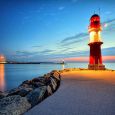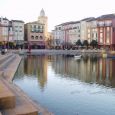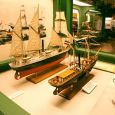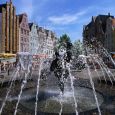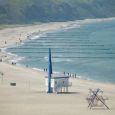Rostock
Advertisement
By Air
The nearest international airports are in Hamburg and Berlin.There are connecting flights via Munich to Rostock Laage Airport.There are also a number of airfields for smaller aircraft, e.g. Purkshof.
By Train
Rostock Hauptbahnhof (Rostock Central Station) offers fast rail connections to Hamburg and Berlin and from there to almost any other European city.Within the city a wide network of trams, buses and ferries is available.The first privately financed tunnel in Germany crosses the Warnow river and thus connects the eastern part of Rostock with the western part.
By Car
Rostock can be reached by motorway (Autobahn) A 1 from Hamburg via Lübeck on A 20 and by A 19 from Berlin and A 20 from Stettin in Poland.
By Ferry
Rostock is Germany's largest Baltic port. Rostock is also home to a large ferry port.It is a main base for ferry operators Scandlines, Tallink and TT-Line, which both connect Rostock with major Scandinavian destinations. Furthermore, Rostock receives the highest numbers of cruise tourists in Germany per year.
Advertisement
St. Mary's Church
is the biggest of three town churches found in the Hanseatic city of Rostock, in northern Germany. The other two are St. Petri (Petrikirche) and St. Nicholas (Nikolaikirche). A fourth, St. James (Jakobikirche), was heavily damaged during the Second World War and subsequently demolished. St. Mary's was designated in 1265 as the main parish church and since the protestant reformation in 1531 it's the house of the Evangelical-Lutheran Congregation.St. Mary's Church Marienkirche, on Ziegenmarkt, is a large Brick Gothic church. Built in the 13th century, it was enlarged and modified at the end of the 14th century into the present basilica. The first reference to a church on this site is in 1232, which is thought to be the predecessor of the current building. The triple-nave cross-shaped basilica is in Brick Gothic, a building style typical of the Hanseatic port cities of northern Germany. The huge tower with a baroque lantern at the top was not completed until the end of the 18th century.
The Academy of Music and Theatre
In the late 19th century, Edward H.R. Lyman, a philanthropist and Northampton native, had a vision for a new venue for culture and theater in his hometown. On May 23, 1891, the 800-seat Academy of Music Theatre opened its doors to the public for the first time. One year later, Lyman deeded the Academy to the City of Northampton, making it the first municipally-owned theatre in the nation.The theatre quickly became a favorite stop on the tours of leading troupes and big-name performers: legendary French stage actress Sarah Bernhardt, film star Mae West, and illusionist Harry Houdini all performed at the Academy in the early 20th century.The Academy has evolved over time. As Americans became less interested in live theater through the 1950s and 1960s, the theatre experienced a period of decline and was ultimately condemned. In the 1970s it was reborn with great success as a cinema for first-run films. But in the shadow of the multiplex, the Academy began to lose its vitality once more.Today, the Academy of Music has been reclaimed as a venue for live theater, as well as for dance, film, music and arts education. The Academy is home to resident companies: the Pioneer Valley Ballet, Old Deerfield Productions, Greene Room Productions, and the Pioneer Valley Symphony. We have built relationships with our partners WGBY, the Out! For Reel film series, and the Pioneer Valley Performing Arts Charter Public School. The Academy continues to present major performance groups from all over the world.
Warnemunde
is the seaside part of Rostock and a major attraction of the city. Locals and tourists alike enjoy the maritime flair of old houses, a large beach, a lighthouse and the old fisherman port.Founded in about 1200, Warnemunde was for centuries a mere fishing village with minor importance for the economic and cultural development of the region. In 1323 Warnemunde lost its autonomous status as it was purchased by the city of Rostock in order to safeguard the city’s access to the Baltic Sea. It was not until the 19th century that Warnemunde began to develop into an important sea resort. Today Warnemunde has approximately 8,400 inhabitants.In the vicinity of the canal called der Alte Strom (Old Channel), with its various restaurants, pubs and traditional fishing boats, regional specialties are offered in a fish market.
Cultural History Museum
The Cultural History Museum celebrated its 100th in 2006 Birth-day. Despite the large stock losses at the end of the second World War II and the heavy part of devastation suffered by the building at this time, the outstanding artistic detail solutions of Architects and the "exceedingly picturesque effect" of the overall impression after the recovery today as in the founding of the museum is still admired. The museum is currently undergoing something of a renaissance, which involves, first, return to the early history and associated to the picturesque and historicist disposition of this attractive house, on the other, but also opens a new approach to international museum scene. The sensible further development and gradual rehabilitation takes place in a difficult process of reclassification of all Museums in Magdeburg.The great international success and the 27th Europe Euro Exhibition "Otto the Great, Magdeburg and Europe" in 2001 confirmed the concept that holds in the coming years, with highlights enriched exhibition program. Two of the most prominent projects were the city history exhibition to mark "Magdeburg 1200 - medieval metropolis, Prussian fortress, the City" (2005) and "The Holy Roman Empire of German Nation 962-1806 - From Otto the Great to the end of the Middle Ages" (2006), a joint project with the German Historical Museum in Berlin.Recently, the museum presents exhibitions with the "spectacle of power. Rituals in Old Europe" (2008), a collaboration with the University of Münster, and "Dawn of the Gothic," the 800-year-old cathedral's jubilee (2009) are two very successful projects.
Ecomuseum Warnemunde
For over 70 years, the Fischer House 31 Alexandrinenstraße domicile of the local museum Warnemünde.On 12 February 1914 was proposed at a meeting of "Low German association" in Warnemünde: "The club may operate the collection of historically and culturally important historical things, it is high time that we now make a start is by traders very carried away a lot."The fisherman H. Holtfreter presented a collection of fishing implements are available. Others brought what they discovered at his home and considered worthy of collection. Soon the museum had several hundred items in his possession.It took almost 20 years for the Low German Association of Rostock and the surrounding area was a fisherman's house like the house of the milliner Christine young man.Up to this point, the collection on the first floor of the Fritz-Reuter-school was housed.
Shipbuilding and Maritime Museum
The maritime museum in Rostock shows a focus on the shipbuilding history of the Baltic Sea coastal region from the construction of Slavic dugout canoes to modern production of steel and special cargo ships. The tour takes you to the diorama of a sailing ship Stralsund shipyard to a ship's carpenter's workshop of the 18th Century, the model of the first seagoing iron screw steamer of Germany (1851), to the revival of the shipbuilding industry after the Second World War.The focus of the exposition focuses on the presentation of the shipbuilding industry of the GDR, the presentation of products of the East German shipyards and the suppliers of the combine shipbuilding.
January - April
September - December
Information not available
Advertisement

